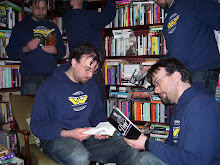On a number of occasions I've drooled, both privately and
publicly, over both the contents and covers of the New York Review Books series. It seems to me that, unless you're trying to create a massive, all-encompassing library of "classic" books--more, to be honest, than any one person is likely to ever read--along the lines of Penguin Classics, then the NYRB way is the way to go.
Since the 1990s it has grown into an extensive collection of frankly amazing diversity and quality: about the only times I don't buy one of their new releases is when the book is either one I already own (usually in a much uglier version), or else the topic is of narrowly American-centric focus. This means that each year still seems to provide a couple of dozen books of staggering awesomeness. I mean, I just looked at their upcoming books on Amazon, and my mind is boggled: Thomas Tryon! Erich Kastner! Natsume Soseki! Renata Adler! Kingsley Amis! Saki and Edward Gorey! Russell Hoban!
Holy shit!
Anyway, to calm down and get to what I'm here for, they've just published the first in their ebook-only series, NYRB Lit. I assume the rationale here is that these books are those that are unlikely to make back the costs of physical publishing, but which are too good to languish unpublished in the US market. I've been lucky enough to read two of them, Lindsay Clarke's
The Water Theatre and Zena el Khalil's
Beirut, I Love You: A Memoir, both of which are marvellous in entirely different ways. The former reminded me at times, in the best possible way, of two of my favourite writers: Graham Greene and Ronan Bennett. The later is a superb and funny autobiography about growing up a dishevelled artist in Lebanon (and Lagos and New York). Zena el Khalil also provides a wonderful alternative to the usual po-faced author photograph.
As with all ebooks, discussions of the covers is potentially difficult, in that the books don't exist as objects. NYRB have not used their usual Katy Homans-created series design. Instead they've gone with the covers-as-icons idea, using a nearly square format, with each one designed by Ian Durovic Stewart. Click for bigger versions...
I really like these. Looking at them, I was reminded what designer Ian Shimkoviak
said in his guest post here in July:
[M]any people doing e-books will ask that the title type be very big and legible at a small thumbnail size. This is not a critical request in my opinion as most reader devices clearly list the name of the product next to it in a legible font. Most people will probably click on something because the image is strong and enticing rather than the type being massive. So this request I often find naive and irritating as it really sets the tone for a cover that is ugly and obnoxious looking.
These NYRB Lit covers seem to me to idealise the ebook cover possibilities. They
do have large type, legible at small sizes, but it's well-integrated into the design, and very attractive. The images are well-chosen, and the overall effect, with its layering and texturing, makes you wish these were physical objects you could look at in the real world. I hope they do sell well enough to spawn paper editions.
I know this all sounds like something of a love letter. But I'm not ashamed to admit that I've frequently shared my bed with a NYRB book, and sometimes more than one. If we must have ebooks, and it seems we must, let these be the sort of ebooks that triumph.
























































